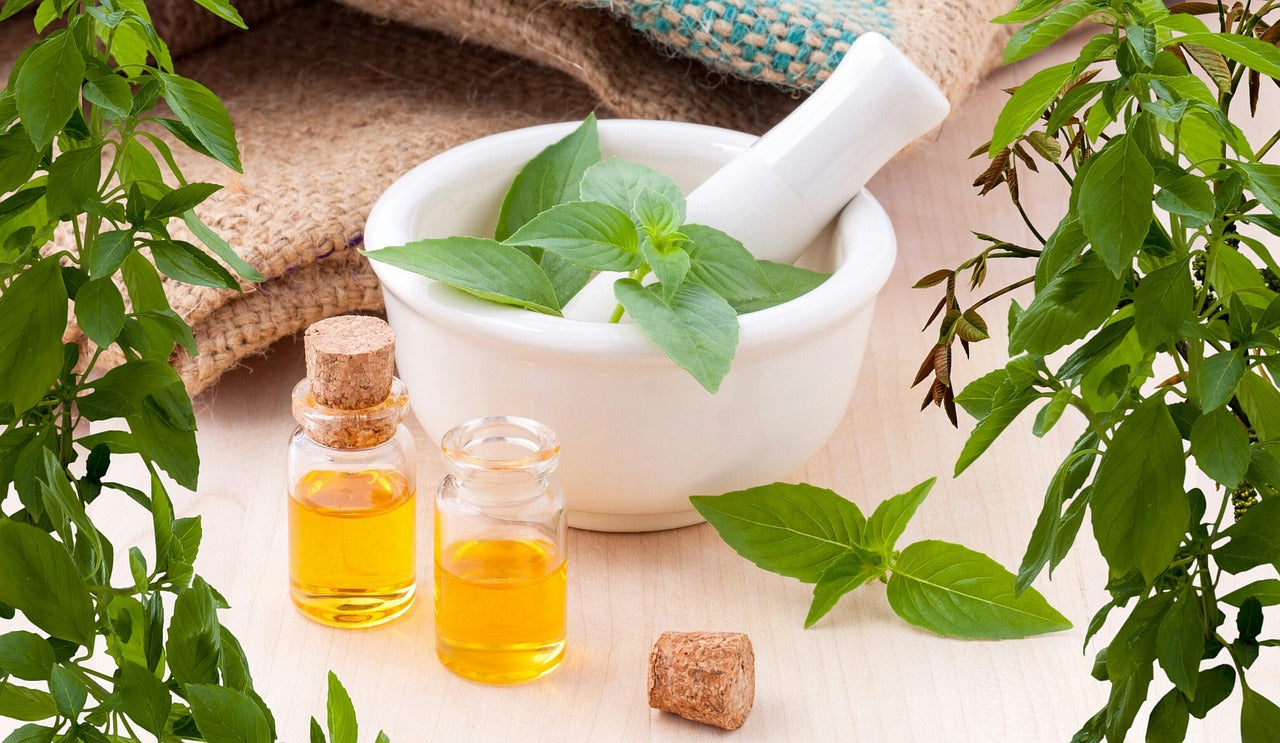
Natural Ways to Relieve Pain and Discomfort
Share
Aside from the usual over-the-counter pain relief that many turn to when looking to manage symptoms, there’s a whole host of natural ways to relieve pain and discomfort.
By exploring these treatment methods, or simply introducing aspects like anti-inflammatory foods and nutrients into your diet, your pain can be improved. Things like eating healthily, exercising regularly, and using red light therapy can do more good for you than you may realize.
As always, you should consult with your doctor before starting any specific treatment plans.
Herbal Remedies and Essential Oils

Herbal remedies come from plants, usually a combination of the leaves, flowers, or roots - with each part having a different medicinal use.
For example, lavender and rosemary can help ease pain and peppermint can help reduce inflammation, along with eucalyptus.
While a plant may seem like it won’t alter the body, you should treat these with the same respect as conventional medicines. It would be wise to consult your doctor about plans to take herbal medicines beforehand, especially if you have surgery coming up.
Some people should avoid herbal treatments, including pregnant or breastfeeding women, the elderly, children, people with serious health conditions, and those who are taking other medicines.
You should be cautious of where you buy herbal medicines from as there could be risks from ordering online.
The Benefits of Herbal Remedies and Essential Oils
Depending on the herbal remedy you choose, benefits include reducing stress, promoting relaxation, clearing sinuses, and reducing nausea.
This method is natural and can be very accessible too, especially the oils, but there are negatives to bear in mind.
Why it Works
Herbal remedies come from an ancient form of healing as herbs have been used in most traditional cultures for centuries.
Herbs contain naturally occurring chemicals that have biological activity and they can work similarly to traditional pharmaceuticals. Morphine is produced from the opium poppy and others are derived from plants too. A trained herbalist will be able to give a full rundown on which herbs target different ailments.
Acupuncture and Acupressure

Known as ancient Chinese medicine, acupuncture is the practice of inserting needles into the body to stimulate sensory nerves in the skin and muscles.
While that sounds like it would only bring on more pain it’s actually a relatively pain-free method. Some people report a tingling sensation or a dull ache when the needle is inserted, but this usually subsides.
There are around 20 commonly known styles, all of which utilize hair-thin needles. If this becomes your go-to natural way to relieve pain and discomfort, you must ensure you’re going to a licensed and certified acupuncturist. Preferably, this person will have lots of experience and be able to answer any burning questions you may have.
There are some potential side effects to be aware of like bleeding, bruising, and soreness at the insertion sites. In rare cases, other side effects can occur so talk this through with your doctor to see if it’s for you.
The Benefits of Acupuncture and Acupressure
The benefits of acupuncture can be difficult to measure as it’ll vary depending on your situation, but it’s a non-invasive treatment that is relatively low-risk.
Why It Works
It’s believed to release endorphins which are the body’s natural painkillers, helping to reduce pain. It’s also said to improve blood circulation which can aid the healing process as more blood is pumped to the painful area, bringing with it nutrients while flushing out the nasties.
Exercise and Physical Therapy

Use it or lose it as the doctors say!
Depending on the intensity of your pain and where it’s located, targeted exercises can help rebuild strength and increase flexibility.
This doesn't have to be anything strenuous and can be built up over time. Some low-impact options include walking, swimming, and yoga. All of which can be the first steps to gaining confidence and some ability back into the painful place.
The Benefits of Exercise and Physical Therapy
Exercise is a pain management tactic that can lead to a reduced need and reliance on medication. Benefits include improvement of mobility, movement, and function as well as the fostering of healthy muscles, bones, and joints.
Regular participation in physical activity is reported to reduce depression, improve mood, and aid pain too.
Unlike many others, this treatment is free. If a physical therapist is involved, this will incur a cost if not covered by healthcare but they’ll set you on the right path before you can go off and do it yourself.
Why It Works
When exercising, the body releases endorphins. These are the chemicals that block pain signals from reaching the brain and have been found to alleviate anxiety and depression too.
It can build strength which will make the muscles stronger, helping to take the load off bones and cartilage. Over time, this reduces pain.
Joints can become more flexible with exercise as well which increases motion which can boost quality of life.
Mindbody Techniques

Mindbody techniques include practices that boost interactions between the mind, body, and behavior.
This could be art therapy, counseling, yoga, breathwork, meditation, music therapy, or tai chi.
All of these are natural and promote good health. It’s believed these can regulate bodily functions and symptoms while relaxing the body and mind.
The Benefits of Mindbody Techniques
Mindbody techniques encourage relaxation, improve coping skills, reduce tension, stress, and strain as well as hopefully lessen the need for medication.
These are great self-care practices that should be implemented into daily life regardless of pain!
Why It Works
Aside from physical pain, mind-to-body connection can calm your mind and lower stress levels which can alleviate mental health conditions like anxiety and depression.
Meditation, for example, is like a workout for your brain. It will encourage you to observe passing thoughts without judgment and release them, resulting in a better regulation of emotional reactivity and stability.
When engaging in these practices, feel-good neurotransmitters like serotonin and dopamine are released.
Red Light Therapy

Red light therapy is an extremely beneficial and non-invasive treatment for easing pain, reducing inflammation, and improving mobility.
While the healing powers of light have been known for a while, NASA catapulted red light therapy into the stratosphere when they noticed that red and near-infrared light wavelengths could penetrate deep beneath the skin and stimulate cellular activity. Since then, red light therapy has grown exponentially in popularity.
The treatment triggers a series of effects. When the wavelengths reach the mitochondria (the mighty powerhouse of our cells), the production of adenosine triphosphate (ATP) is amplified which is the fuel our muscles need to repair and regenerate.
When these ATP levels increase, cellular activity is boosted - leading to quicker healing. Blood circulation is also enhanced, which means more oxygen and nutrients can reach the muscles more efficiently, further aiding the recovery process.
The Benefits of Red Light Therapy
The benefits of red light therapy are vast, especially so with Kineon. The MOVE+ Pro has been created to empower customers as the device can be used at home, when and wherever is needed.
The MOVE+ Pro is a portable, safe, and enhanced light therapy device with the following benefits:
Non-invasive: Non-thermal with minimal side effects, making it a safe and gentle option for muscle recovery.
Cost-effective: Investing in a red light therapy device for home use saves you money, as it eliminates the need for repeated professional sessions.
Customizable: Adjustable to your needs as it can be applied to various muscle groups.
Convenient: You don’t have to carve time out of your day to go and complete treatment. Simply put it on the area and carry on with your day.
Accelerated Muscle Healing: Red light therapy stimulates cellular repair and regeneration, facilitating faster healing of damaged muscles.
Reduced Muscle Soreness: By targeting inflammation and increasing circulation, our at-home treatment can help alleviate muscle soreness and stiffness, allowing for effective pain management.
Why It Works
Red light therapy helps pain by increasing the energy in cells, as this aids better blood flow which is vital for healing.
Heightened blood flow results in more oxygen and nutrients being delivered to the injured or painful area. The oxygen supports cell growth and protein synthesis (a huge component of recovery), and the blood is also able to carry waste away from the area.
The waste is carried by the blood to the kidneys, where it’s filtered out of the body. Thus, the improved levels of oxygen and nutrients help the injury to heal sooner.
In terms of nutrients, vitamin C and zinc can be moved to the relevant area, which creates collagen. This is useful for forming tendons and soft tissue. Amino acids are involved too, helping with muscle repair and protein synthesis.
Not only will red light therapy lead to faster recovery times for those suffering from pain, but you’ll have less swelling and inflammation too.
Physical Changes
If your pain hasn’t been brought on by an illness, injury, or condition, it could be a combination of daily lifestyle choices.
For example, it could be your office chair causing you problems so switch this out for an ergonomic design. This should give you proper lumbar support, minimizing the strain on the lower back and spine.
Similarly, your posture could be the one to blame as this can impact your whole upper body, affecting the lower back and upper muscles.
The Benefits of Making Physical Changes
Being more aware of your posture and how your environment can bring on pain and discomfort can be quick, easy, and affordable changes.
Why It Works
It can seem menial, but having poor posture every day can cause tension. When improved upon, the strain can lessen.
The supraspinatus tendon runs through a space at the top of the shoulder bone (called the subacromial space). When you slouch or even round your shoulders, this space narrows. As a result, there’s less room for the supraspinatus tendon to run through.
This then leads to the tendon becoming pinched and grating against the padding in the shoulder, resulting in shoulder-related impingement, swelling, and inflammation. Taking physical changes into account, this can then be prevented from occurring.
For more articles on biohacking read:
